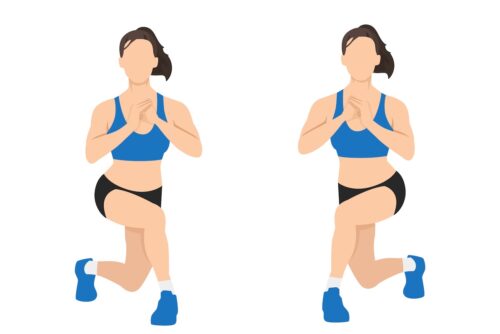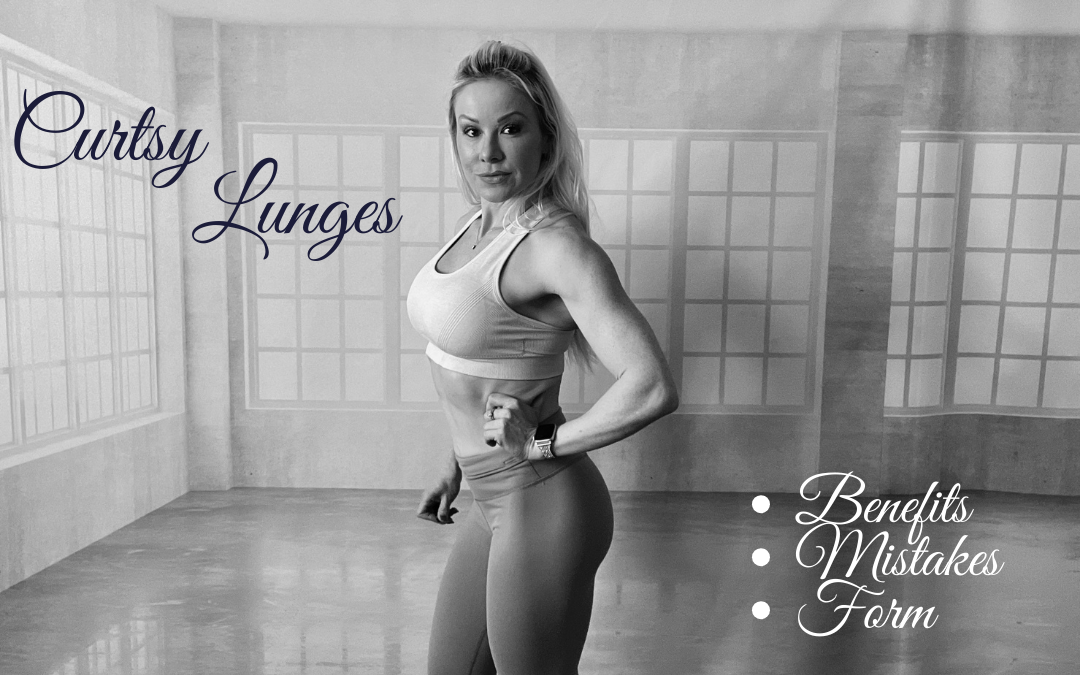Strength training for the lower body is crucial for several reasons. It’s not only important for muscle development, enhanced athletic performance, and increased caloric expenditure but also essential for joint and bone health, injury prevention, and functional movements. Lunges are great for the legs and glutes. Let’s look into curtsy lunges, the benefits and mistakes associated with them, how to perform curtsy lunges, and ideas for a lower body workout.
What Muscles Do Curtsy Lunges Work?
- Quadriceps: These muscles are located at the front of the thighs and are composed of four muscles (rectus femoris, vastus lateralis, vastus medialis, vastus intermedius). The quadriceps are involved in postural support, knee extension (required for standing up, walking, running, and jumping), stabilization of the kneecap, hip flexion (lifting the thigh toward the torso, and deceleration during activities. Curtsy lunges engage the quadriceps as you bend your knees and lower your body.
- Hamstrings: These muscles are located at the back of the thighs and are composed of three muscles (biceps femoris, semimembranosus, semitendinosus). The hamstrings play a role in postural support, knee stabilization, knee flexion (required for bending the knee joint during walking, running, and jumping), hip extension of the hip (necessary for standing up from a sitting position and straightening the hip when walking or running), and control of leg rotation. Curtsy lunges engage the hamstrings as you push back up from the lunge position.
- Gluteus: There are three main muscles that make up the gluteus muscles (gluteus maximus, gluteus medius, gluteus minimus). These muscles are involved in the extension and outward rotation of the hip joint (needed for sitting, climbing stairs, running, and jumping), hip abduction and internal rotation, and pelvis stabilization. The curtsy lunge activates more the gluteus medius and minimus since it involves a lateral movement.
- Adductors: These muscles are located on the inner side of the thigh. They are responsible for hip adduction (bringing the legs toward the midline of the body) and hip joint stabilization. The side-stepping motion in the curtsy lunge engages the adductors.
- Calves: These muscles are located at the posterior area of the lower leg. The calves consist of gastrocnemius and soleus muscles. They are involved in flexing the foot at the ankle joint and the leg at the knee joint -important for running, walking, and jumping. The calf muscles are involved in stabilizing the ankle and foot during the lunge movement.
Secondary muscles involved:
- Core muscles: The core refers to the muscles in the abdomen, lower back, pelvis, and hips. These muscles work together to maintain proper posture, support the spine, and facilitate various movements. The core muscles play a crucial role in providing stability, support, and movement for the body. Core muscles help maintain balance and stability throughout the curtsy lunge.
Benefits of Curtsy Lunges
Here are some benefits of incorporating curtsy lunges into your workout routine:
- Leg and Glute Muscle Hypertrophy: Curtsy lunges place a strong emphasis on the quadriceps, hamstrings, adductors, calves, and glute muscles, helping to shape all these muscles.
- Improved Balance and Stability: Performing curtsy lunges requires stability and balance as you move your body in a diagonal motion. This helps enhance your overall balance and stability, which is beneficial for various daily activities and sports.
- Joint Flexibility: Curtsy lunges involve a dynamic movement that can help you improve joint flexibility, especially in the hips and knees, as it involves a combination of flexion and extension.
- Calorie Burn: This exercise helps you burn a lot of calories since it recruits many muscle groups, making it a valuable addition to any fitness program.
- Functional Movement: Curtsy lunges mimic movement patterns similar to everyday activities, contributing to improved functional fitness.
- Core Activation: These lunges engage your core muscles in order to help you maintain balance. This strengthens your core and contributes to better posture.
- Variety in Training: Performing different types of leg exercises adds variety to your workout routine and helps prevent boredom and plateaus. This different movement pattern adds diversity to your lower body training.
- Versatility: This is a very versatile movement that can be performed by anyone at any level. You can use just your body weight or incorporate dumbbells, kettlebells, or a barbell, allowing for scalability based on fitness levels.
- Low Impact: Compared to some high-impact exercises, curtsy lunges are relatively low-impact, making them suitable for a wide range of fitness levels and ages.
How to Do Curtsy Lunges

- Stand with your feet hip-width apart and your shoulders relaxed.
- Start by standing up straight, shoulders back, chest up, core tight, and with your feet hip-width apart.
- You can place your arms by your sides or in front of you. If you want to increase the resistance, grab a pair of dumbbells, a barbell, or a kettlebell. Always start with a light weight or no weight at all until you are comfortable with the movement.
- As you exhale, take a step back and diagonally across behind your front leg, similar to the motion of a curtsy. Your back foot should end up behind and to the side of your front foot.
- Lower your body down by bending both knees. Aim to bring your back knee close to the ground without touching it.
- Keep your front knee directly above your ankle.
- Maintain your back straight, chest up, shoulders back, and engage your core for stability throughout the movement.
- As you inhale, press through your front heel to return to the starting position. Bring your back foot to meet your front foot.
- You can repeat the movement on that leg for the desired number of reps or perform the same movement on the other leg and alternate sides.
Mistakes Associated with Curtsy Lunges
After learning how to perform curtsy lunges correctly, you can take into account some of the common mistakes that people may make during this exercise:
- Poor Alignment: One common mistake is poor alignment of the knees and feet, as this can put unnecessary stress on the knee joint. Don’t allow your front knee to collapse inward. Make sure that your knees are tracking in line with your toes without going past your toes, that your front knee is directly above your ankle, and that your back knee is pointing toward the ground.
- Stepping Too Far: Some individuals may overreach or step too far back during the curtsy lunge, leading to instability and a compromised form. Instead, focus on taking a controlled step back and maintaining a stable stance throughout the movement.
- Forward Leaning: Leaning too far forward during the lunge can shift the emphasis away from the targeted muscles and place strain on the lower back. Keep your torso upright, engage your core, and focus on a controlled descent and ascent.
- Incorrect Foot Placement: Ensure that your feet are positioned at an appropriate width. Your feet should be hip-width apart, and your toes should be pointing forward. Avoid allowing your feet to turn outward or inward excessively.
- Not Engaggin Your Core: Neglecting to engage your core can lead to instability during the curtsy lunge. Keep your core muscles activated to stabilize your spine and maintain proper posture throughout the movement.
- Rushing the Movement: Performing curtsy lunges too quickly can compromise form and balance, and increase the risk of injury. Take your time and focus on controlled, deliberate movements, paying attention to your body positioning and muscle engagement.
- Improper Range of Motion: Failing to achieve an adequate range of motion can limit the effectiveness of the exercise. Having a short range of motion doesn’t allow you to step back far enough to feel a stretch in your hip and glute muscles. Having an extra long range of motion may not allow you to get back up from the lunge or may throw you off balance.
Curtsy Lunges Video Tutorial
The following video shows how to perform curtsy lunges:
Lower Body Workout
You can complete your lower body workout by performing the following exercises:
- Good Mornings
- Goblet Squats
- Front Lunges
- Single-Leg Romanian Deadlifts
- Reverse Lunges with Knee Hops
The curtsy lunge is a variation of the tradicional lunge and a powerful lower body exercise. Avoid the most common mistakes associated the curtsy lunge to achieve the amazing benefits linked to this exercise.
Whether you want to lose weight, tone your body, gain muscle, or get stronger, all muscles must be trained. Lift, Burn more Fat, Get Stronger, and Live Healthier!
To a Fitter Healthier You,
The Fitness Wellness Mentor



